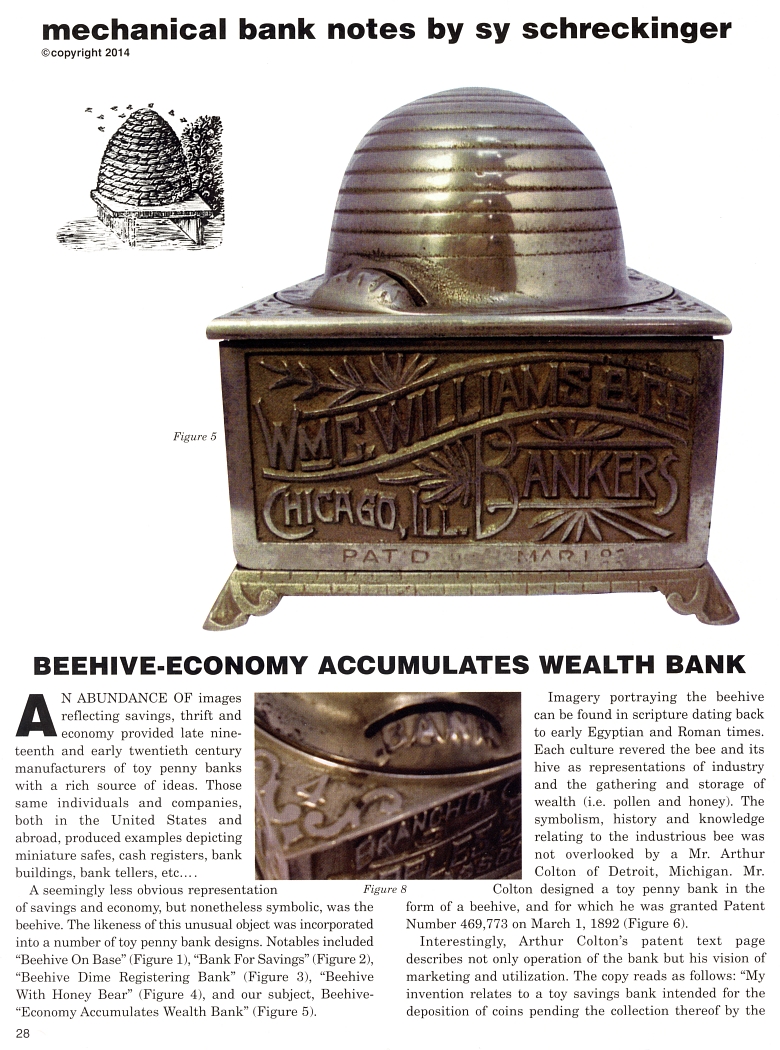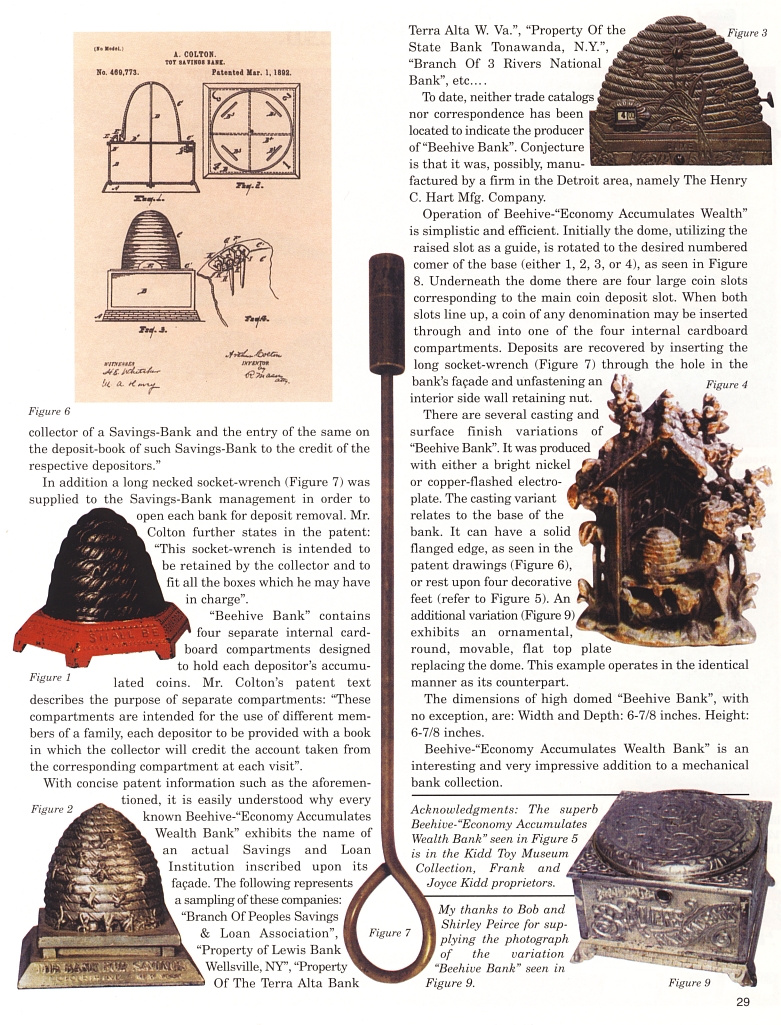|
Beehive-Econmy
Accumulates Wealth Bank
by Sy Schreckinger – ANTIQUE TOY WORLD Magazine – July, 2014
AN ABUNDANCE OF images reflecting savings, thrift and economy provided
late nine-teenth and early twentieth century manufacturers of toy penny
banks with a rich source of ideas. Those same individuals and companies,
both in the United States and abroad, produced examples depicting
miniature safes, cash registers, bank buildings, bank tellers, etc....
A seemingly less obvious representation of savings of savings and
economy, but nonetheless symbolic, was the form of a beehive, The
likeness of this unusual object was incorporated into a number of toy
penny bank designs. Notables included "Beehive On Base" (Figure 1),
"Bank For Savings" (Figure 2), "Beehive Dime Registering Bank" (Figure
3), "Beehive With Honey Bear" (Figure 4)1, and our subject,
Beehive- "Economy Accumulates Wealth Bank- (Figure 5).
Imagery portraying the beehive can be found in scripture dating
back to early Egyptian and Roman times. Each culture revered the bee and
its hive as representations of industry and the gathering and storage
of wealth (i.e. pollen and honey). The symbolism, history and knowledge
relating to the industrious bee was not overlooked by a Mr. Arthur
Colton of Detroit, Michigan. Mr. Colton desigmed a toy penny bank in the
form of a beehive, and for which he was granted Patent Number 469,773 on
March 1, 1892 (Figure 6).
Interestingly, Arthur Colton's patent text page describes not only
operation of the bank but his vision of marketing and utilization. The
copy reads as follows "My invention relates to a toy savings bank
intended for the deposition of coins pending the collection thereof by
the collector of a Savings-Bank and the entry of the same on the
deposit-book of such Savings-Bank to the credit of the respective
depositors."
In addition a long necked socket-wrench (Figure 7) was supplied to
the Savings-Bank management in order to open each bank for deposit
removal. Mr. Colton further states in the patent: "This socket-wrench is
intended to be retained by the collector and to fit all the boxes which
he may have in charge".
"Beehive Bank" contains four separate internal card-board
compartments designed to hold each depositor's accumulated coins. Mr.
Colton's patent text describes the purpose of separate compartments:
"'These compartments are intended for the use of different members of a
family, each depositor to he provided with a book in which the collector
will credit the account taken from the corresponding compartment at each
visit".
With concise patent information such as the aforementioned, it is
easily understood why every known Beehive-"Economy Accumulates Wealth
Bank" exhibits the name of
an actual Savings and Loan Institution inscribed upon its facade. The
following represents a sampling of these companies: "Branch Of Peoples
Savings & Loan Association",
"Property of Lewis Bank Wellsville, NY", "Property Of The Terra Alta
Bank Terra Alta W. Va.", "Property Of the State Bank Tonawanda, N.Y.",
"Branch Of' 3 Rivers National Bank", etc....
To date, neither trade catalogs nor correspondence has been located
to indicate the producer of "Beehive Bank". Conjecture is that it was,
possibly, manufactured by a firm in the Detroit area, namely The Henry
C. Hart Mfg. Company.
Operation of Beehive-"Economy Accumulates Wealth" is simplistic and
efficient. Initially the dome, utilizing the raised slot as a guide, is
rotated to the desired numbered comer of the base (either 1, 2, 3, or
4), as seen in Figure 8. Underneath the dome there are four large coin
slots corresponding to the main coin deposit slot. When both slots line
up, a coin of any denomination may be inserted through and into one of
the four internal cardboard compartments. Deposits are recovered by
inserting the long socket-wrench (Figure 7) through the hole in the
bank's facade and unfastening an I; interior side wall retaining nut.
There are several casting and surface finish variations of "Beehive
Bank". It was produced with either a bright nickel or copper-flashed
electroplate. The casting variant relates to the base of the bank. It
can have a solid flanged edge, as seen in the patent drawings (Figure
6), or rest upon four decorative feet (refer to Figure 5). An additional
variation (Figure 9) exhibits an ornamental, round, movable, flat top
plate replacing the dome. This example operates in the identical manner
as its counterpart.
The dimensions of high domed "Beehive Bank", with no exception,
are: Width and Depth: 6-7/8 inches. Height: 6-7/8 inches.
Beehive-"Economy Accumulates Wealth Bank" is an interesting and
very impressive addition to a mechanical bank collection.
Acknowledgments: The superb Beehive-"Economy Accumulates Wealth
Bank" seen in Figure 5 is in the Kidd Thy Museum Collection, Frank and
Joyce Kidd proprietors.
My thanks to Bob and Shirley Peirce for supplying the photograph of
the variation "Beehive Bank" seen in Figure 9. |


